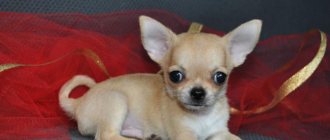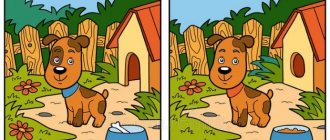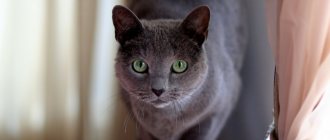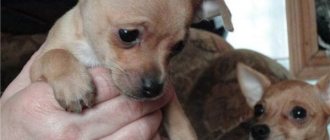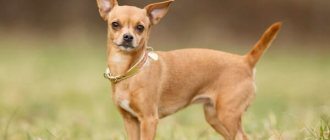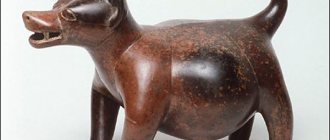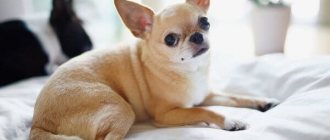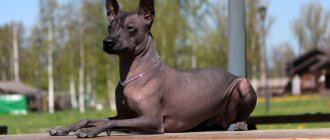Once you see long-haired Chihuahuas, they are not easy to forget.
Small dogs with soft, silky fur, grace, a cheerful nature and curiosity, have captivated dog lovers around the world.
But before you buy such a dog, you should know better about its character and the necessary care.
In our article we will tell you everything about this breed, and also show photos of its representatives.
History of the breed
The Chihuahua is a dog breed originally from Mexico . Its name is a modified transcription of the name of the Mexican state of Chihuahua.
The exact time of domestication of these dogs is unknown, but the history of the Chihuahua goes back thousands of years, because the first mentions of them are associated with the Mayan Indians.
It is believed that Chihuahuas lived in the wild for some time and were only discovered by the Mexicans at the end of the 19th century. The small dogs were liked by Americans who bought them at the market. This is how the breed came to the USA, and then to Europe.
Chihuahuas were first officially presented to the public in 1884 at a dog show held in Philadelphia.
NOTE!
In 1959, Fidel Castro gave two long-haired puppies to Nikita Khrushchev as a sign of friendship among peoples. This is how Chihuahuas ended up on the territory of the CIS.
A little history
The homeland of the Chihuahua - black, white and any other permitted color - is considered to be Mexico. According to one of the existing versions, they descended from aboriginal dogs of the Toltec tribe, who lived about eleven thousand years ago. These miniature individuals bore the exotic name “techichi” and had a striking resemblance to modern sneezes. The ancient Mexicans had expressive round eyes and a tail that curled over the back.
After the Aztecs came to Mexico and conquered most of the lands of the local Indians, aboriginal dogs were elevated to the rank of divine animals, which only the leaders had the right to own. The first Chihuahuas had fairly long hair. Individuals with short fur were developed through crossing with Mexican hairless dogs.
They arrived in Europe in the 16th century. For unknown reasons, the local population remained indifferent to these cute creatures. They became popular only a few centuries later, after American dog handlers became interested in them. In 1923, the Chihuahua breed standard was officially approved in the United States. Around the same time, the first club for lovers of these tiny animals was organized.
Description and standard
Long-haired Chihuahuas are small dogs with a compact body. Adults reach 15-23 cm at the withers, weight – 1-3 kg.
Below is a more detailed description of this breed.
The coat is thin and silky, and can be smooth or wavy. It is desirable to have a not too thick undercoat. On the ears, neck, back of the paws and tail, the hair is longer and forms feathers.
The head is round, apple-shaped. The muzzle tapers towards the nose, the transition to the forehead is wide and pronounced.
The lips are dry, tightly attached, and have a scissor or straight bite.
The eyes are round, convex, and dark in color.
The ears are erect, wide at the base and gradually tapering, with rounded tips.
The limbs are straight, set parallel. The paw pads are oval, small, elastic and developed.
The tail is of medium length, set high, thick at the base and tapering towards the end.
Types of haircuts
There are 2 types of hairstyles in demand: model, hygienic. The first option applies to exhibition Chihuahuas. A professional chooses the haircut himself, focusing on the dog’s main advantages and masking any shortcomings, if any.
The model look does not exclude the use of decorative ornaments.
A hygienic haircut is performed up to twice a month, allowing the pet to feel more comfortable. By removing excess hair length, the dog's skin begins to breathe better.
Classic option: shortening hair on the sides, back, with lengthening in the neck, ears, and limbs. Under the paws, in the groin area, chest, the pet’s fur is carefully trimmed.
Character traits
They are friendly, cheerful, active and curious dogs. They become attached to all family members, but they always choose one person as their main owner and remain faithful to him.
The Chihuahua always strives to be close to its owner, accompany him everywhere and easily adapts to his lifestyle and mood. When left alone, the dog becomes sad.
They expect the same attitude in return - they need constant attention and care. They strive to achieve them with all their might, sometimes becoming too intrusive.
In general, they get along well with children, but their patience is not unlimited and, if a child accidentally hurts them, they may bite in return.
They get along well with other pets if they grew up together; they treat unfamiliar animals and people with suspicion.
They are brave and courageous and, if necessary, can get into a fight even with larger dogs.
Without proper training , the willful nature of these dogs takes over, and the pet can grow up uncontrollable and aggressive.
Expert opinion
Kozhevin Semyon Kirillovich
Expert dog handler.
When purchasing a Chihuahua, it is important to understand that small size does not guarantee obedience and lack of aggression. Only proper upbringing and competent training can provide such a guarantee. Long-haired Chihuahuas have a rather loud and ringing bark, with the help of which they notify about all unfamiliar and suspicious sounds, and this is not bad. It’s bad that they can bark for no reason, out of boredom, drawing the owner’s attention to themselves.
Chihuahua temperament
Adult dogs may not show their own character right away. They look closely at their new owner for several weeks. The owner may even think that the dog is timid. But the point is different: she is trying to calculate who will be the master of the house. The dog’s Mexican past comes into play here. Her ancestors used to live in the jungle. To survive, they tried to develop their attention and be extremely careful.
The ancestors of modern Chihuahuas had to make efforts on themselves in order to survive
For a small breed, the dog has a fairly high and loud voice. The height of such a baby does not exceed 20 centimeters. Long-haired Chihuahuas live for about 15 years.
Your pet may suddenly start barking loudly, for no reason. And it will be difficult to calm the dog down. Long-haired Chihuahuas do not like restless children and are suspicious of all strangers they see. When a dog gets scared, it can wet itself instantly.
Frequent changes in mood are characteristic of Chihuahuas; this breed does not tolerate monotony.
In a familiar environment, the baby becomes an energetic and cheerful leader. Watching him is a real pleasure. The dog will twirl amusingly under your feet, and then suddenly lie down to rest in a corner or crawl under the blanket and snore charmingly. Moreover, it is not by chance that a Chihuahua sniffs like that - it has to do with the specific structure of the skull.
Dogs feel great in small city apartments. If the puppy is left alone for a long time, he begins to feel sad.
Many Chihuahuas do not like competition for attention and want to be the most loved.
The Chihuahua's devotion borders on jealousy. The dog tries not to let the owner out of his sight. Because of their own loyalty, the brave little ones often provoke the aggression of larger dogs. Sometimes this results in injuries to the Chihuahua.
Read even more information about this breed in a special article on our website.
Difference from smooth-haired dogs
The main difference between this variety is its rather long coat, which makes them more demanding to care for.
Read about other varieties of Chihuahua here.
Fluffy Chihuahuas tolerate cold more easily and can overheat when sitting in the owner’s arms for a long time.
They are also distinguished by seasonal shedding, while the smooth-haired variety sheds throughout the year.
What colors are there?
The most common colors :
- red – red shades of fur from red to light red are allowed, most often it is supplemented with areas of other colors, for example, white;
- black – solid black is rare; black and white is more common.
Chocolate , white , brindle, lilac and blue are also found , but these colors are considered rare.
Advantages and disadvantages
In addition to their compact size, long-haired Chihuahuas have a number of other advantages:
- devotion to the owner;
- cheerful disposition;
- ability to learn;
- mind;
- Possibility of training to a tray or diaper.
Flaws:
- seasonal shedding - a lot of hair falls out;
- the need for proper education;
- tendency to obesity;
- intolerance of loneliness.
CAREFULLY!
The coat of these dogs contributes to the development of allergic reactions, so this variety of Chihuahua is not suitable for allergy sufferers.
Behavior and skills
Despite their miniature size, long-haired Chihuahuas are confident dogs. Pets often show fearlessness and love of freedom. Cowardice and passivity are not their traits.
A properly raised dog exhibits ideal behavior. The pet does not bark for no reason, does not get into fights with other dogs, does not defecate at home, and adapts to the owner’s mood. The dog will never make noise if the owner is in a bad mood.
Pets tolerate travel well and sit patiently in a bag. Dogs love walks and entertainment, but Chihuahuas gravitate even more towards the comfort of home.
Expert opinion
Anna Abramenko
An avid dog lover. Experience in veterinary medicine since 2009.
Ask a Question
Chihuahuas are jealous, vulnerable animals. Screaming can push a dog away from family members for a long time. The pet can even refuse to eat. The dog is sad without attention. You cannot leave your dog alone for a long time.
Dogs do not trust strangers, they are afraid of guests entering the house, and they can bite while protecting the owner.
There is no authority among other animals for the Chihuahua. Dogs are able to sort things out with representatives of larger breeds.
Life expectancy, illness and health
The average life expectancy of these dogs, provided proper care and living conditions are provided, as well as with proper feeding, is 12-15 years.
Despite their miniature size, Chihuahuas have fairly good health.
However, there are still some diseases that representatives of this breed are prone to:
- knee joint injuries;
- jaw dislocation;
- gum disease, tartar formation;
- fractures;
- rheumatism;
- ophthalmological diseases;
- diseases of the cardiovascular system;
- demodicosis;
- epilepsy;
- hypoglycemia;
- progressive retinal atrophy.
IMPORTANT!
Due to the specific structure of the skull, Chihuahuas are more susceptible to developing hydrocephalus than other breeds.
Often the cause of pathologies is improper care of the pet. Thus, constant consumption of food or water with a high content of mineral salts leads to the development of urolithiasis in a dog, and overfeeding or the use of an unbalanced diet in combination with low physical activity is the cause of Chihuahua obesity.
In addition, some diseases can occur due to the presence of internal or external parasites - fleas or ticks, so it is necessary to carry out timely deworming, treat your pet for parasites, follow a vaccination schedule and regularly visit the veterinarian for routine examinations.
Breed diseases
Chihuahuas (black, fawn, brindle and any others) are distinguished by excellent health. They have a very strong immune system, so they rarely get sick. But, like any other creature, these little ones are prone to some breed ailments. They often have problems with vision and the cardiovascular system.
These miniature creatures are often diagnosed with dislocations, as well as dysplasia of the hip or elbow joints. In addition, chocolate, Isabella, or black Chihuahua puppies suffer from hypoglycemia.
How to properly care?
These are exclusively domestic dogs and are not suitable for street keeping, even with an insulated enclosure. They are sensitive to low temperatures and will need warm clothing for walks in the cold season.
Wool and bathing
To avoid the formation of tangles and maintain an attractive appearance (a well-groomed dog always looks better than a shaggy one), the coat of these dogs must be combed daily, and during shedding, which usually lasts 10-14 days, several times a day using a special brush with medium bristles. rigidity.
Chihuahuas should be bathed as they become dirty, preferably no more than once every 3-4 weeks, using hypoallergenic shampoo for long-haired dogs.
Bathing too often destroys the natural waxy layer that protects the dog from pests and insects.
A haircut
Long-haired Chihuahuas need a haircut. It can be model and hygienic.
A model haircut is required for dogs participating in exhibitions and competitions, otherwise it is quite hygienic. It is carried out 2 times a month and consists of shortening the fur on the back, belly and sides, while leaving it a little longer on the tail, paws, ears and neck.
NOTE!
Grooming not only gives the dog a neat appearance, but also minimizes the risk of skin diseases.
Teeth
Teeth are the weak point of this breed.
Often baby teeth fall out later than expected, which leads to the formation of an incorrect bite; Chihuahuas are also prone to caries, exposed tooth necks and the formation of tartar.
brush your pet’s teeth three times a week with a special toothbrush and toothpaste.
Eyes, claws and ears
Your Chihuahua's eyes should be treated with moisturizing drops weekly. These dogs are prone to increased lacrimation due to which tear tracks appear on the face. This is not a pathology and treatment with drops in most cases solves this problem.
The claws of representatives of this breed do not grind down on their own, so they need to be trimmed with a guillotine nail clipper 2 times a month.
Chihuahuas, as a rule, do not have problems with their ears, but if the dog constantly touches them, the ears have taken on an unnatural shape and begin to emit an unpleasant odor, it is important to consult a veterinarian for a diagnosis.
Pricing Features
There are various ways to purchase a Chihuahua puppy. You can buy it in a nursery, which will cost much more, because there you can only find a purebred puppy that meets all or almost all breed standards. The price of such an acquisition starts from 25 thousand rubles and ends at 50 thousand .
You can purchase a puppy from a private person. Such a dog often does not have a passport or pedigree, it does not meet breed standards, and its age may vary. This option is much cheaper, its cost starts from 4 thousand rubles . By the way, among private advertisements you can also find offers to purchase quite rare representatives of the breed (for example, chocolate-colored Chihuahuas) and their cost is in no way inferior to what is asked in the nursery.
The age of the dog also affects the cost. You can buy a rare puppy at a low price just because he is not young (from three years old). In this case, its cost will start from 10 thousand rubles . The same applies to the physical characteristics of the animal. The more deviations from the standard, the lower the cost.
Another purchase option is a non-purebred animal. For example, it could be a mix of a Chihuahua with another breed of small dog. Such an animal will cost very little, from 5,000 rubles . Suitable for those who are interested in the characteristics of the breed, and not its standards.
Education and training
The opinion that dogs of decorative breeds do not need training is fundamentally wrong. Training with a Chihuahua should be approached as responsibly as possible, otherwise this small dog will grow up uncontrollable and aggressive.
These are not guard or service dogs, but the Chihuahua is capable of mastering a set of basic and most necessary commands, such as “stand”, “sit”, “wait” and “come”.
Classes should be carried out an hour after feeding. The dog must be active and full of energy, otherwise the training will not be beneficial.
After each completed command, the pet must be praised and treated with a treat. If a dog has done something wrong, you should not physically punish it. Commands are reinforced by regular repetition after changing the training location.
Training
Just like any other dog, sneezing needs training. He must know several basic commands, including “Come”, “Fu” and “Place”. It is advisable to start raising a puppy immediately after it arrives in your home. You should not allow your baby to do things that would be prohibited to an adult pet. For example, if you don’t want your dog to lie on your sofa later, don’t let him there from the first days.
Don't pamper your miniature pet too much. Otherwise, the tiny animal will very quickly turn into an arrogant, smug and poorly controlled creature. To develop the correct behavioral skills, you need to start socializing the puppy as early as possible. It is important that he is given the opportunity to communicate with his relatives and meet new people... many sneezes are prone to barking for no reason. Therefore, you need to immediately pay attention to this moment and wean your baby from this habit.
How to feed?
The diet of long-haired Chihuahuas can consist of natural products or ready-made food, the main thing is that it is balanced.
Both types of food cannot be mixed - this has a negative impact on the pet’s health.
Up to 2 months, a Chihuahua puppy needs to be fed 6 times a day, then the frequency of feedings is gradually reduced - a one-year-old dog should eat twice a day.
At three months, representatives of this breed undergo the final formation of taste, they remember the taste of the food they like and in the future they often become capricious and refuse to eat some foods.
With a natural diet, the Chihuahua's diet should include boiled meat, lean fish, cereals, low-fat dairy products, vegetables and fruits. In addition, be sure to give your pet additional vitamins and minerals.
It is forbidden to feed the dog:
- raw chicken meat; sausages;
- pork;
- smoked, fried, salted foods;
- sweets;
- flour and pasta;
- onions;
- bones.
It is also prohibited to feed your pet from a common table.
IMPORTANT!
Chihuahuas are prone to food allergies, so new foods must be introduced into the diet with extreme caution.
Feeding dry food is the most suitable option for these dogs. The food granules help clean teeth and enamel from plaque, and its composition is balanced and contains the necessary amount of vitamins and minerals.
You should choose premium or super-premium food.
Popular and proven brands of feed:
- Pronature;
- Probalance;
- Pro Plan;
- Bosch;
- Acana;
- Hills;
- Royal Canin.
Feeding recommendations
Representatives of this breed can be given both industrial and natural food. In the first case, preference should be given to super-premium products produced by trusted global manufacturers who value their own reputation. It is important to ensure that the brand you choose does not contain wheat, corn, artificial colors or preservatives.
Those who prefer to feed their black Chihuahua with natural products need to remember that the basis of his diet should be meat. It could be beef, lamb or poultry. A couple of times a week, the meat component can be replaced with low-fat sea fish and offal. It is also advisable to include cereals, vegetables, fruits, cottage cheese, kefir, yogurt and chicken eggs in the menu of a miniature pet. It is strictly forbidden to treat these little ones with sweets, smoked meats, pickles and tubular bones.
Price range
Prices for long-haired Chihuahua puppies range from 15 to 100 thousand rubles.
Speaking about cost, it is worth clarifying that:
- the price of bitches is higher on average by 30%;
- if the predicted weight of an adult dog is 1.5 kg, its cost increases;
- brindle, blue and chocolate colors are the most expensive;
- the puppy's titled parents are another reason to increase the price.
Also, a puppy with a strong build and thin limbs will cost more.
What does the price depend on?
First of all, the price of a dog depends on its physical characteristics. Such as:
- Gender of the dog, females are cheaper.
- Size, the larger the dog, the cheaper it is.
- Length of coat, dogs with long coats are cheaper.
- Coat color (rare ones include chocolate, blue, brindle).
- Chihuahuas with a long muzzle and long legs are correspondingly cheaper.
Among other things, the price of a breed may depend on factors such as:
- Availability of passport and pedigree.
- Availability of awards and achievements, prizes in competitions.
- Purpose of sale (for example, profit, urgent need, etc.).
- Place of purchase (nursery or private owner).
How to choose a puppy?
It is best to buy a puppy in a specialized nursery from trusted breeders - this eliminates the possibility of purchasing a sick, non-purebred dog.
External signs of a healthy puppy that meets the standard:
- apple-shaped head;
- straight or scissor bite;
- ears are clean, without discharge, unpleasant odor or signs of irritation;
- nose is cold and wet;
- the coat is thick and soft, possibly wavy;
- skin without rash, dandruff and redness.
A healthy puppy should be active, playful and curious; if he constantly lies or hides, he is probably sick or cowardly, and excessive thinness indicates the presence of helminths in the body.
